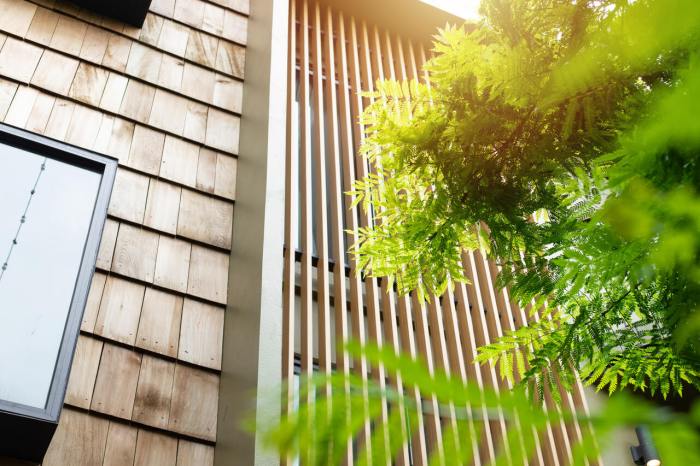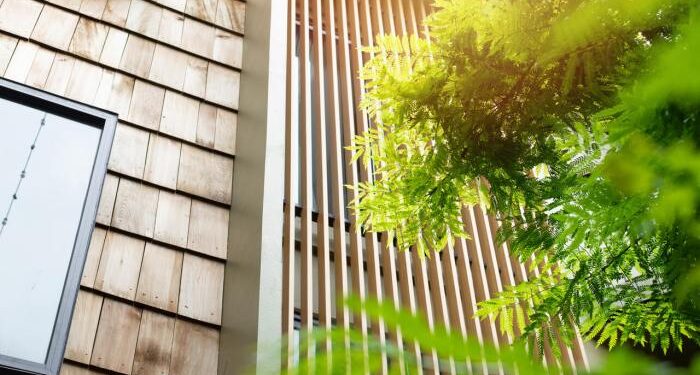Exploring the realm of Eco-friendly siding options for sustainable buildings unveils a world where environmental consciousness meets architectural innovation. From reclaimed wood to recycled metal, the possibilities are as diverse as they are eco-friendly. Dive in to discover a greener way to build for the future.
Types of eco-friendly siding materials
Reclaimed wood, fiber cement, recycled metal, and engineered wood are some of the popular eco-friendly siding options used in sustainable buildings. These materials offer various benefits in terms of durability, energy efficiency, and environmental impact, making them ideal choices for green construction projects.
Reclaimed Wood
Reclaimed wood siding is sourced from salvaged wood, such as old barns or factories, giving it a unique and rustic appearance. This eco-friendly material helps reduce deforestation and waste, making it a sustainable choice. Additionally, reclaimed wood is known for its durability and natural insulation properties, contributing to energy efficiency in buildings.
Fiber Cement
Fiber cement siding is made from a mix of cement, sand, and cellulose fibers, offering a low-maintenance and long-lasting alternative to traditional siding materials. This eco-friendly option is resistant to rot, fire, and pests, providing excellent durability for sustainable buildings.
Fiber cement siding also helps improve energy efficiency by providing insulation and reducing heating and cooling costs.
Recycled Metal
Recycled metal siding, often made from aluminum or steel, is a durable and sustainable option for eco-friendly buildings. Using recycled metal helps reduce the environmental impact of mining and manufacturing new materials. Metal siding is also highly resistant to weather elements, corrosion, and pests, making it a long-lasting choice for sustainable construction projects.
Engineered Wood
Engineered wood siding is manufactured from wood fibers, resins, and wax, providing a sustainable alternative to solid wood siding. This eco-friendly material offers high durability, dimensional stability, and resistance to moisture and insects. Engineered wood siding is a cost-effective option that mimics the look of natural wood while reducing environmental impact through sustainable manufacturing practices.
Installation considerations for eco-friendly siding
When it comes to installing eco-friendly siding options for sustainable buildings, there are several key considerations to keep in mind to ensure a successful and efficient installation process.
Installation Process
- Begin by preparing the surface where the siding will be installed, ensuring it is clean, smooth, and free of any debris or obstacles.
- Follow the manufacturer's instructions carefully for the specific eco-friendly siding material you are using, as installation methods can vary.
- Secure the siding panels in place using the recommended fasteners and techniques to ensure they are properly attached and will withstand the elements.
- Finish the installation by sealing any gaps or joints to prevent moisture infiltration and ensure the siding is properly insulated.
Special Tools and Techniques
- Some eco-friendly siding materials may require specialized tools for cutting and installation, so be sure to have the necessary equipment on hand.
- Consider using environmentally-friendly adhesives and sealants to minimize the environmental impact of the installation process.
- Consult with a professional contractor if you are unsure about any specific tools or techniques required for installing eco-friendly siding.
Insulation and Moisture Protection
- Proper insulation is crucial when installing eco-friendly siding to ensure energy efficiency and maintain a comfortable indoor environment.
- Use weather-resistant barriers and flashing to protect the siding from moisture damage and prevent water infiltration into the building.
- Regularly inspect the siding for any signs of damage or wear and address any issues promptly to maintain its effectiveness.
Maintenance and Cleaning
- Regularly clean eco-friendly siding using mild soap and water to remove dirt, grime, and mold buildup that can compromise its appearance and performance.
- Avoid using harsh chemicals or abrasive cleaners that can damage the siding material and harm the environment.
- Inspect the siding annually for any signs of damage or wear, and make any necessary repairs or replacements to prolong its lifespan.
Environmental impact of eco-friendly siding
When it comes to the environmental impact of eco-friendly siding, it is essential to consider various factors that contribute to sustainability and overall eco-friendliness. This includes analyzing the sustainability credentials of different siding materials, their recyclability and biodegradability, as well as how they contribute to energy efficiency and indoor air quality.
Sustainability credentials of eco-friendly siding materials
Eco-friendly siding materials are known for their use of sustainable resources and low carbon footprint compared to traditional siding options. Materials such as reclaimed wood, bamboo, cork, and recycled metal are popular choices that help reduce the overall environmental impact of construction projects.
These materials are sourced responsibly, often from renewable sources, and require minimal processing, leading to lower carbon emissions
Recyclability and biodegradability of eco-friendly siding options
One of the key benefits of eco-friendly siding is its recyclability and biodegradability. Many eco-friendly siding materials can be recycled after their lifespan, reducing waste and promoting a circular economy. Additionally, some materials, like wood and bamboo, are biodegradable, further minimizing their impact on the environment.
Contribution to energy efficiency and indoor air quality
Eco-friendly siding options can also contribute to energy efficiency and indoor air quality in buildings. Materials with high thermal resistance, such as cork and insulated vinyl siding, can help reduce energy consumption for heating and cooling, leading to lower carbon emissions.
Moreover, these materials are often free from harmful chemicals and volatile organic compounds (VOCs), improving indoor air quality and creating a healthier living environment.
Reducing overall environmental impact in construction
By choosing eco-friendly siding options, builders and homeowners can significantly reduce the overall environmental impact of construction projects. From sourcing sustainable materials to promoting energy efficiency and improving indoor air quality, eco-friendly siding plays a crucial role in creating more sustainable and environmentally friendly buildings.
Making informed choices about siding materials can lead to long-term environmental benefits and a greener future for construction practices.
Design trends and aesthetic considerations
When it comes to eco-friendly siding for sustainable buildings, design trends play a crucial role in enhancing the overall look and feel of a structure while also promoting environmental sustainability.
Current design trends in eco-friendly siding
- Bio-based siding materials like bamboo and cork are gaining popularity due to their renewable and biodegradable nature.
- Modern minimalist designs with clean lines and geometric shapes are being favored for a sleek and contemporary look.
- Mixing different siding materials such as wood, metal, and recycled plastic to create a unique and dynamic facade.
Complementing architectural styles with siding materials
- Wood siding can complement traditional and rustic architectural styles, adding warmth and texture to the building.
- Metal siding is ideal for modern and industrial designs, offering a sleek and durable finish.
- Fiber cement siding works well with transitional and contemporary styles, providing versatility and low maintenance.
Color options and finishes for eco-friendly siding
- Earth tones like brown, green, and gray are popular choices for eco-friendly siding, blending harmoniously with natural surroundings.
- Matte finishes are trending for a modern and understated look, while textured finishes can add depth and visual interest to the facade.
- Custom colors and finishes can be achieved through eco-friendly paint or stains, allowing for a personalized touch to the building's exterior.
Innovative designs integrating eco-friendly siding
- Living walls with plant-covered siding panels not only enhance the aesthetic appeal but also contribute to improved air quality and insulation.
- Vertical or horizontal slat arrangements using sustainable materials create visual interest and play with light and shadow for a dynamic facade.
- Combining traditional materials like wood with modern techniques such as prefabricated panels for a blend of old-world charm and contemporary design.
Outcome Summary

In conclusion, Eco-friendly siding options offer not just a sustainable choice but a stylish one too. From reducing environmental impact to enhancing energy efficiency, these materials pave the way for a brighter, greener future in construction. Embrace the change, and let sustainability be the cornerstone of your next building project.
FAQs
What are some common eco-friendly siding materials?
Common eco-friendly siding materials include reclaimed wood, fiber cement, recycled metal, and engineered wood.
How do eco-friendly siding options contribute to energy efficiency?
Eco-friendly siding options often provide better insulation, reducing the need for extra heating or cooling, thus improving energy efficiency.
Are eco-friendly siding materials more expensive than traditional options?
While initial costs may be higher, the long-term benefits of durability and energy efficiency often make eco-friendly siding options cost-effective in the long run.



